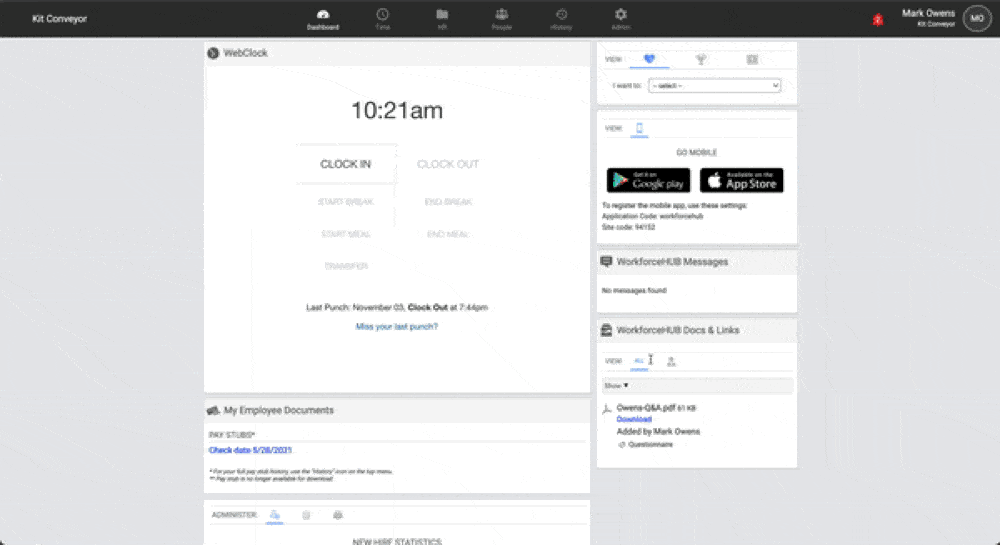How Employee Appreciation Creates a “Best Place to Work”

Chances are, some of your employees are looking elsewhere for work right now. Start showing appreciation and they may reconsider. Companies with employee recognition programs have 31% lower voluntary turnover (Deloitte).
Employees who have the leeway to rearrange, modify, and improve their assignments feel possession over them, and once this happens, their mindsets begin to change. Michael O'Malley in the Harvard Business Review
Research shows that feeling a sense of belonging leads to a 56% increase in job performance and a 50% reduction in the risk of employee turnover. Belonging even brings down sick days by 75%. Employees that feel belonging are engaged, happy, and excited to come to work every day. Erin Etough, PhD Senior Insights Manager at BetterUp
It takes effort to “unlearn” non-inclusive behavior, so don’t expect things to change overnight. Make a long-term commitment to creating an inclusive culture and monitor progress along the way.
Would your small business make it onto a “100 Best Places to Work” list? If you’ve read about the companies that achieve this honor, you’ve probably noticed that whatever differences they may have, they all have a culture of employee appreciation.
Employee appreciation is essential if you want your small business to be a great place to work. Unfortunately, research reveals that businesses with a culture of recognition are the exception.
In a TINYpulse survey with 200,000+ participants, only 25% of respondents reported feeling like they are highly valued at their organization. That means three fourths of the workforce frequently feel under-appreciated.
Managers have the greatest responsibility, followed by the executive team. Gallup found that managers account for 70% of the variance in team engagement.

A Recognition Wall Makes Employee Appreciation Easy
If there is not a recognition program at your company, consider starting one soon. It doesn’t need to be elaborate to be powerful–and software can help. HR portals with a recognition wall allow managers to give kudos their team members in a company-wide forum. This is especially important if you have 100% remote employees or hybrid schedules. When your team doesn’t share a physical space, you have to be intentional with all communication and engagement programs. (The animation above shows the recognition wall function in WorkforceHub, a small business time and labor solution.)
Are you a manager? Set a reminder to give kudos to each employee for something specific they did in the preceding week. It may feel forced and awkward at first. Over time, however, you will get better at noticing employees’ contributions, which will make the messages more authentic.
Recognition Lowers Turnover
Chances are, some of your employees are looking elsewhere for work right now. Start showing appreciation and they may reconsider. Companies with employee recognition programs have 31% lower voluntary turnover (Deloitte). Giving consistent, meaningful recognition doesn’t just help employees thrive, it improves business performance.
Make Your Small Business a “Best Place to Work”
Recognition is the first step. Let’s discuss three additional characteristics of a world-class small business: trust, transparency and belonging.
Trust Employees
It’s important that employees trust management and leadership. Here, we’re focusing on leadership trusting employees. You hired each team member to do a job. If you don’t give them the freedom to do it, they won’t own the outcome. Micromanaging drains enthusiasm, stifles innovation and doesn’t unlock your employees’ potential. Let your employees use their expertise and ingenuity. Also, let them fail fast and safely. Otherwise, they will never take chances.
A Utah-based manufacturing company in the energy industry has nailed this one. When I spoke with a former employee, he said the company uses the Kaizen approach to create a culture of continual improvement. Managers and leadership trust employees to find ways to solve problems and improve operations on every team. Although many manufacturing jobs are physically demanding and repetitive, this company’s employees are fiercely loyal. Because of oil and gas industry fluctuations, the company lays off a significant portion of its labor force every few years. The fact that laid off employees can’t wait to be hired back when the industry rebounds makes it a legit “best place to work.”
Micromanaging Crushes Engagement
Contrast this with an employee who left a firm last month because he wasn’t allowed to use his skills. In the exit interview, he said, “I was hired to take the lead, own my work and advise the team. However, my boss didn’t rely on my expertise and continually dictated changes.” The employee was hired to make conceptual decisions but ended up with a far less strategic role.
Good leaders can build trust even in highly structured positions. For starters, involve employees in planning and goal setting. Give them flexibility in scheduling with a virtual shift trade board. Let them solve problems on their own.
Employees who have the leeway to rearrange, modify, and improve their assignments feel possession over them, and once this happens, their mindsets begin to change. Michael O’Malley in the Harvard Business Review
Be Transparent
If the past years have taught us anything, it’s that employees care about business transparency. Whether there is good news or bad news, leadership needs to consistently inform employees. Life is more stressful now for most everyone. When employers aren’t open with their staff, it adds another layer of uncertainty. Employees are concerned about return to work plans, office health and safety, and vaccine and mask rules.
If your business is struggling, your employees may be worried about being let go. It’s okay if plans are fluid, but leaders should explain why. Better yet, seek employees’ feedback. Even if you can’t grant every request, your employees will appreciate (there’s that word again) being consulted. Give their input careful consideration and let them shape policies where possible. As mentioned, if your company has a hybrid or remote work model, you’ll need to communicate more often using multiple channels.
Anonymous Suggestion Box
Some employees may want to give anonymous feedback. An HR portal with an anonymous suggestion box allows employees to give feedback and recommendations in a safe space.
Foster a Sense of Belonging
Perhaps your org has the previous characteristics but you have employees who don’t feel like they belong. If this is the case, you won’t be a “best place to work” from their perspective. A sense of belonging is the inclusion part of diversity, equity, and inclusion (DEI).
Social belonging is a fundamental human need, hardwired into our DNA. And yet, 40% of people say that they feel isolated at work, and the result has been lower organizational commitment and engagement. Evan W. Carr, Andrew Reece, Gabriella Rosen Kellerman, and Alexi Robichaux in the Harvard Business Review
Helping all employees feel like they belong starts with hiring a diverse workforce to begin with. Once they’ve joined your company, make sure everyone has an equal chance for promotions. Scrutinize your culture for non-inclusive language and practices and provide DEI training if necessary. It takes effort to “unlearn” non-inclusive behavior, so don’t expect things to change overnight. Make a long-term commitment to creating an inclusive culture and monitor progress along the way.

Research shows that feeling a sense of belonging leads to a 56% increase in job performance and a 50% reduction in the risk of employee turnover. Belonging even brings down sick days by 75%. Employees that feel belonging are engaged, happy, and excited to come to work every day. Erin Etough, PhD, Senior Insights Manager at BetterUp
In conclusion…
Small businesses have much to gain by creating a culture of appreciation, trust, transparency and belonging. Above all, employee will be happier and more loyal. Furthermore, you’ll increase productivity and decrease absenteeism. An improved employer brand will help you attract employees in today’s competitive labor market.
If you have an HR portal, use it to recognize employees and request feedback. If you don’t have an HR portal, request a WorkforceHub demo today.
Simplify HR management today.
Simplify HR management today.
Navigating the Complexities of Healthcare Recruitment
The healthcare sector is renowned for its rewarding nature, offering professionals the chance to significantly impact individuals’ lives by aiding in their recovery from various ailments and conditions. However, for those tasked with recruitment within this sector, the challenges are plentiful. Delve into our in-depth guide for an array of strategies to elevate your healthcare…
Read MoreHow Improving Candidate Engagement Influences the Hiring Process
Applicants invest considerable time, effort, and thought into their job applications. Regrettably, it’s all too common for employers to delay responses, with some failing to provide any follow-up whatsoever. Such practices can have a negative effect on the candidate experience, influencing your organization’s hiring efficiency and reputation. Ensuring a positive experience for candidates is crucial…
Read More





